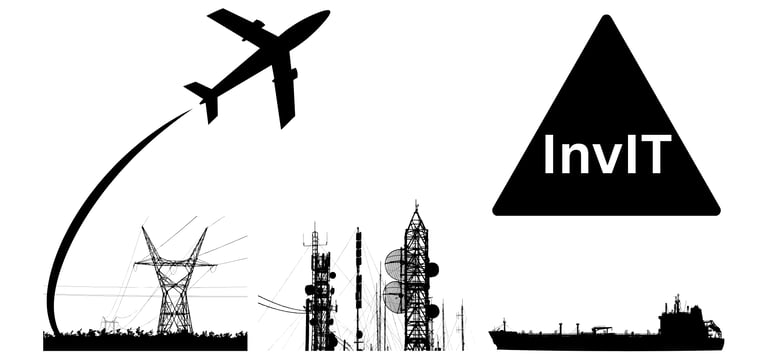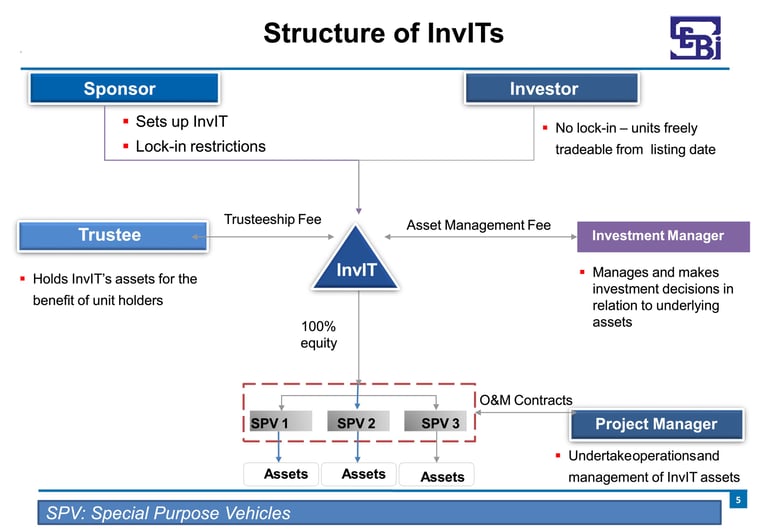InvITs for retail investors
Understanding the another alternative investment and its rationale behind nation building. Know more about its structure, cash flow and assess the riskyness in comparison to other investments.
INVESTMENT OPPORTUNITYECONOMICSMACRO ECONOMYSTOCK MARKETINVESTMENT
Nagaraj Basarkod
7/31/20255 min read


Investment, a topic that often stimulates curiosity and anxiety in the minds of retail investors. Like many other sectors, finance market in India is catching up with the west. For majority of Indian’s the scope of the word investment is limited to Stock Market, MFs or Real Estate. InvITs are too young to gain the popularity and many are oblivious of the investment opportunity.
Infrastructure Investment Trusts are the SEBI registered trusts sponsored by infra developers. InvITs pool the money from diverse set of investors to fund, own and operate infrastructure projects. InvITs are similar to mutual funds, investors receive the units in return. Investors get the share in the revenue generated by assets in the form of dividends. Unlike mutual funds these units provide liquidity and can be traded in the open market (NSE & BSE) if the InvIT is publicly listed.
REITs (Real Estate Investment Trusts) were invented by the US in 1960. Rest of the globe copied the concept. India was late to the party, it introduced InvITs and REIT in 2014. InvITs are creaed to utilise the capital for the projects like, power transmission, highway, ports, rail, fibre optical network, railway, telecom towers, ports, power plants, pipelines, etc… InvITs received a warm welcome by the financial markets and institutional investors. The first publicly issued IRB InvIT fund in May-2017 was over subscribed by 8 times.
What are InvITs?
Economics of InvITs
Infrastructure projects are crucial for the economy because of the multiplier effect. Projects are resource and capital intensive and often categorised as public goods and the government funds the projects.
India is the largest democracy, one among the largest economies, and geographically 7th largest and a peninsula. World class infrastructure is the need of the hour and there is sufficient headroom for growth. Indian govt decided to spend ₹ 11.21 lakh crore ($128.64 billion), ~3.1% of GDP with the hope of crowding in effect. India needs ~$4.5 trillion investment in infrastructure till 2030 to reach its aspirations of growth.
In the mathematical formula of economy, GDP = C + I + G + NX, InvITs contribute for the Investments (I). Government spending (G) on infrastructure through initiatives like, National Infrastructure Pipeline, Atmanirbhar Bharat, Sagar Mala Projet, … to attract new businesses to invest in the economy. Increased I & G will automatically boost the consumption (C), increases business activity and productivity leading to positive next exports (NX).
Multiplier effect of the money or an investment depends on the propensity of the consumer to spend. In India economy, the money gets trapped as savings. InvITs play a crucial role in bringing that money back into the economy as an investment. InvITs raise money from wide diverse set of investors; pension funds, insurance, mutual funds, retail investors, Foreign Institutional Investors (FIIs) are a few to name.
The investors of InvIT get their share of the cash flow generated by the assets in the form of dividends along with capital appreciation of unit value. Investors money gets channelled through special purpose vehicles (SPV) into various projects, mitigating the risks. The structure is such that, the investors own the revenue generating assets without actual ownership.
The trust gets the access to capital at much lower cost. The investment is in asset heavy industry and much lower liquidity. Small and medium businesses in infrastructure sector cannot handle the burden of loans, working capital and maintenance costs; banks shy away from granting loans at lower costs. InvITs acquire and free up the capital for the developers and businesses. InvITs can also lend to projects, the experience and expertise of investment manager and project manager of InvITs come handy in better valuation and assessment of the projects. These alternative sources of capital reduce the burden on banking system.
Structure of InvIT
InvITs are designed to hold and operate the assets on behalf of unit holders and maximise the returns. There are 4 key players in InvIT who are responsible for governance and effective management of the InvIT; Sponsor, Trustee, Investment Manager and Project Manager. InvITs are strictly governed by more than 50% of independent directors and additional disclosure and rating requirements.
Sponsor: A legal business entity responsible for setting up InvIT, appointment of trustee and transfer of initial set of portfolio assets. The net worth of the entity should be at least 100 Crore and proven track record in infrastructure sector. Sponsor must hold minimum of 15% of total units with lock-in period of 3 years.
Trustee: Holds the assets on behalf of unit holders in the name of InvIT. Responsible for overseeing the work carried out by managers and adhere to the operating guidelines of SEBI.
Investment Manager: Looks after the strategic decisions and capital structure of InvIT. Investment and divestment decisions, revenue distribution and necessary disclosures to various stakeholders.
Project Manager: Responsible for operations, management and maintenance of assets held by InvIT.


Cash flow
Investment
InvITs are required to channel the money though SPVs to fund the projects as a holding company and must hold controlling stakes (≥51%).
Publicaly listed InvITs must invest 80% or more of the of the capital in completed and revenue generating assets. Remaining 20% or less can be utilized to acquire or fund the ongoing projects.
Borrowing from banks is permitted for leveraged buyouts and investment needs, but capped at 75% of Assets Under Management (AUM).
Distribution:
InvITs must distribute 90% of the net distributable cash flow. NDFC = profit after tax + depreciation + loss or gain on sale of infrastructure assets – repayment of external dents.
Trusts are pass through structures, income generated is taxed at investors end.
InvIT for retail investors
InvITs are better alteratives if you want to invest for long term and looking for steady cash flow and capital appreciation.
Concern of risk is addressed by diversifying the investments into multiple projects.
Ticks the common checkmarks of traditional investment options like gold, fixed deposit or real estate
Trusted - Registered with SEBI
Tangible - Infrastructure projects
Liquid - Publicaly listed InvITs are traded in open market
Lower risk & descent returns
Sense of ownership of revennue generating assets, without actually owing them.
Diversification of portfolio to include infrastructure.
Let's understand how the InvITs work with an example. Consider you have an opportunity to subscribe for an InvIT and you chose to invest ₹ 100 and received 1 unit. Total capital of InvIT is 10000 and your share is 1%. InvIT must invest minimum ₹ 8000 in revenue generating assets and remaining can be utilized for on going projects.
Assuming InvIT generated the net cashflow of 1000. As per the regulation, you are eligible for ₹ 9 as dividend (90% of 1000 = 900; 1% of 900 = 9).
PowerGrid InvIT was issued in Apr 2021 with unit value of ₹ 100, it has been paying quaterly dividend ₹3/unit. Effectively 12% of annual return, excluding capital appreciation. Let's have a quick comparison of different alternatives.
My Take
InvITs can be another safer alternative to fixed deposits, mutual funds and bonds. They offer a sense of ownership of the projects with right on the revenue, without actually owing them. You contribute directly for the economy and infrastructure development and grow along with the economy hedging the inflation risks. If you are looking to include infra in your portfolio, InvITs are worth giving a thought. Check out the references attached to explore further.
References:
Kashyap, A. K., & Sharma, V. (2024). Project finance through Infrastructure Investment Trust: Legal and regulatory analysis. Risk Governance and Control: Financial Markets & Institutions, 14(2), 65–76. https://doi.org/10.22495/rgcv14i2p7
Critical Assessment of Infrastructure Investment Trusts (InvITs) in India and Suggesting measures to increase their Efficiency in comparison with International Instruments. Malav Shah and Dr. Kedar Bhagwat
TRANSFORMATIVE TRENDS OF INFRASTRUCTURE FINANCE IN INDIA - A PATHWAYS OF VIKSIT BHARAT @2047
Unit holding pattern of PowerGrid InvIT - https://www.bseindia.com/xml-data/corpfiling/AttachHis/7d50e660-2e59-4f4f-9c3b-4daec654a48a.pdf
https://www.pginvit.in/uploads/4ec2685d-ea7a-4371-ade5-103baa5122b6/PGInvIT__2024-25.pdf
Connect
Get in touch for collaborations and inquiries.
+91 - 9738482563
© 2025. All rights reserved.
nagaraj.basarkod@yahoo.in